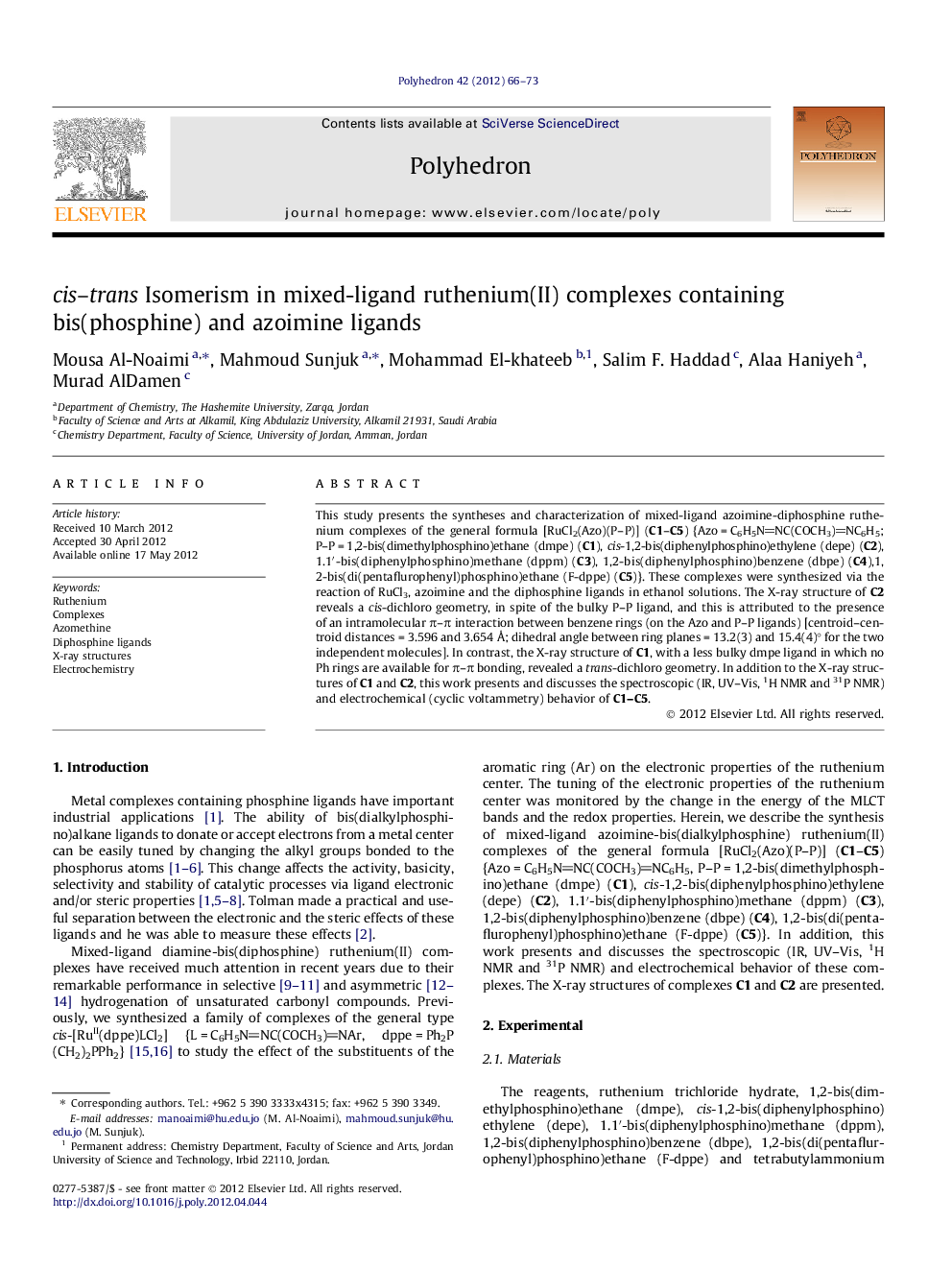| Article ID | Journal | Published Year | Pages | File Type |
|---|---|---|---|---|
| 1337436 | Polyhedron | 2012 | 8 Pages |
This study presents the syntheses and characterization of mixed-ligand azoimine-diphosphine ruthenium complexes of the general formula [RuCl2(Azo)(P–P)] (C1–C5) {Azo = C6H5NNC(COCH3)NC6H5; P–P = 1,2-bis(dimethylphosphino)ethane (dmpe) (C1), cis-1,2-bis(diphenylphosphino)ethylene (depe) (C2), 1.1′-bis(diphenylphosphino)methane (dppm) (C3), 1,2-bis(diphenylphosphino)benzene (dbpe) (C4), 1,2-bis(di(pentaflurophenyl)phosphino)ethane (F-dppe) (C5)}. These complexes were synthesized via the reaction of RuCl3, azoimine and the diphosphine ligands in ethanol solutions. The X-ray structure of C2 reveals a cis-dichloro geometry, in spite of the bulky P–P ligand, and this is attributed to the presence of an intramolecular π–π interaction between benzene rings (on the Azo and P–P ligands) [centroid–centroid distances = 3.596 and 3.654 Å; dihedral angle between ring planes = 13.2(3) and 15.4(4)° for the two independent molecules]. In contrast, the X-ray structure of C1, with a less bulky dmpe ligand in which no Ph rings are available for π–π bonding, revealed a trans-dichloro geometry. In addition to the X-ray structures of C1 and C2, this work presents and discusses the spectroscopic (IR, UV–Vis, 1H NMR and 31P NMR) and electrochemical (cyclic voltammetry) behavior of C1–C5.
Graphical abstractThis study presents the syntheses and characterization of mixed-ligand azoimine-diphosphine ruthenium complexes of the general formula [RuCl2(Azo)(P–P)] (C1–C5) {Azo = C6H5NNC(COCH3)NC6H5, P–P = 1,2-bis(dimethylphosphino)ethane (dmpe) (C1); cis-1,2-bis(diphenylphosphino)ethylene (depe) (C2); 1.1′-bis(diphenylphosphino)methane (dppm) (C3); 1,2-bis(diphenylphosphino)benzene (dbpe) (C4); 1,2-bis(di(pentaflurophenyl)phosphino)ethane (F-dppe) (C5)}. These complexes were synthesized from the reaction of RuCl3, azoimine and the diphosphine ligands in ethanol solution. The product depends on the P–P ligand, a bulky aryl diphosphine ligand gives the cis-[RuCl2(Azo)(P–P)] complex (C2–C5), while the less bulky alkyl diphosphine ligand (dmpe) gives the trans-[RuCl2(Azo)(P–P)] complex (C1). In addition, this work presents and discusses the spectroscopic (IR, UV–Vis, 1H NMR and 31P NMR) and electrochemical (cyclic voltammetry) behavior of C1–C5 and the X-ray structures for C1 and C2.Figure optionsDownload full-size imageDownload as PowerPoint slideHighlights► Mixed-ligand azoimine and diphosphines (P–P) ruthenium complexes of the general formula [RuCl2(P–P)(Azo)] are synthesized. ► The geometry (trans or cis products) depends on the P–P ligands. ► The spectroscopic (31P NMR) and electrochemical (Ru(III/II)) behavior is related to the P–P chelates.
